Medicinal chemists are increasingly exploring strained ring systems, George Barsted reports, believing they can serve as replacements for conventional building blocks in pharmaceuticals
In 1992, the late Philip Eaton, the first person to synthesise the molecule cubane, made an announcement that prompted chemists to reconsider their understanding of the box-like molecule. He suggested that cubane, a highly strained unnatural product, could be used to replace benzene in pharmaceuticals. Over 30 years since Eaton’s announcement, chemists are moving forward with strained bioisosteres that are becoming increasingly accessible to use.
Isosteres were first defined in the 1930s by Hans Erlenmeyer as ‘atoms, molecules or ions with identical peripheral electron distributions’. In 1951, Harris Friedman coined the term ’bioisostere’ to describe molecules conforming to the broadest isosteric definition while retaining similar biological activity. The hunt for bioisosteres meant that scientists could uncover building blocks that overcame problems such as solubility but still maintained the same potency for biological activity. Traditionally this could have been swapping a fluorine for a hydrogen on a compound, or changing a benzene to a pyridine.
Following Eaton’s proposition of cubane as a substitute for benzene, it took nearly two decades for chemists to begin implementing his concepts. Cubane and other strained molecules had made sporadic appearances in literature for medicinal chemists but were largely seen as weird compounds that represented a challenge for synthetic chemists, with a lack of application for biological activity. Before the groundbreaking synthesis of cubane, chemists had wondered whether it was even possible for the molecule to exist, due to the extreme strain placed on the structure with sharp bond angles of 90°. In the end, Eaton and co-collaborator Thomas Cole, proved it to be possible, obtaining a molecule with surprising kinetic stability. With no obvious decomposition pathways for the molecule to take, cubane and similar shaped structures were looked at as potential explosives and energetic materials owing to their stability but also high potential energy.
Craig Williams from the University of Queensland in Australia has conducted research on cubane and other strained ring systems, noting that ’cubane exhibits both structural and electronic similarities and distinctions compared to benzene’. Both cubane and benzene are of similar sizes, cubane having a diagonal width of 2.72Å, which is similar in size to the width of benzene at 2.79Å. While benzene has a much flatter structure than cubane it contains pi bonds that can lead to interactions between other aromatics and cause pi–pi stacking which can be difficult to control. Cubane is rich in sp3 hybridised bonds, lacking any form of aromaticity. One advantage of this is the avoidance of the oxidation of the double bonds in benzene. This can take place in biological systems during metabolism with the cytochrome p450 enzyme, often leading to reactive metabolites with unwanted side effects; the hope is that using cubane can negate this risk.
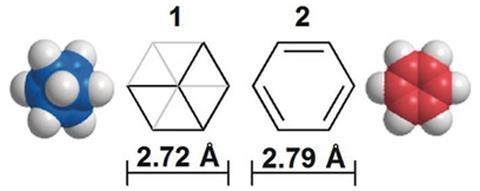
Williams and other collaborators worked to validate Eaton’s hypothesis. Synthesising five common compounds with such as the anaesthetic benzocaine but swapping the phenyl ring for a cubane led to novel compounds like cubocaine. Four out of the five new cubane-containing compounds exhibited either equal or increased bioactivity when tested compared to their parent molecules. The cubane-containing compounds were also more lipophilic than their benzene counterparts, which Williams explains ‘can be an advantage or disadvantage in terms of membrane permeability, metabolism and solubility’. Showing that cubane not only could be incorporated into a variety of compounds from pesticides to medicines, but also be an effective building block, meant that chemists began to think outside of the box when it came to bioisosteres.
The challenge of accessibility
Researchers eager to integrate cubane into the next generation of drugs encountered obstacles, however, not least of which is the difficulty in making cubanes. But recent research by Nobel laureate David MacMillan of Princeton University in the US aims to address some of these challenges. Mario Wiesenfeldt, now at Ruhr-Universität Bochum, worked with MacMillan and other co-workers in making cubanes more accessible for chemists. ‘Cubanes structure can map very well onto benzene,’ Wiesenfeldt says. ‘But the original synthesis by Philip Eaton focuses solely on 1,4-disubstituted cubanes. 1,3- and 1,2-disubstituted cubanes have thus been so difficult to access that people haven’t really used them.’

Susannah Coote at the University of Bath, UK, also collaborated on the study. ‘A 1,2-disubstituted cubane could be seen as equivalent to an ortho substituted benzene, and a 1,3-disubstituted cubane is in a similar spatial arrangement to a meta substituted benzene,’ she says. While Eaton’s original route conquered the synthesis of cubane, it was also fairly long for an eight-carbon molecule, requiring nine steps. ‘You can make the 1,3- or the 1,2-cubanes if you start with a 1,4-cubane, but the available methods were time-consuming and expensive. It’s not convenient,’ Wiesenfeldt says.
The group worked to create two new routes to 1,3- and 1,2-substituted cubanes requiring fewer steps than previous methods. The new route to the 1,2-substituted cubane starts off with a 1,4-substituted cubane and takes only four steps, instead of the eight steps previously required. Using a light-mediated process they attached another carboxyl group to the already disubstituted cubane, leaving the carboxyl group at the four position sterically exposed. Photoredox decarboxylation using an iridium catalyst meant that the exposed group could be removed making 1,2-disubstituted cubanes more accessible.
For 1,3-disubstituted cubanes, they developed a new, convenient route to a highly reactive cyclobutadiene intermediate that undergoes a 4 + 2 cycloaddition to form an endo bisalkene. This new structure was treated with light and underwent a Favorskii rearrangement to form a disubstituted cubane in yields of up to 35%.
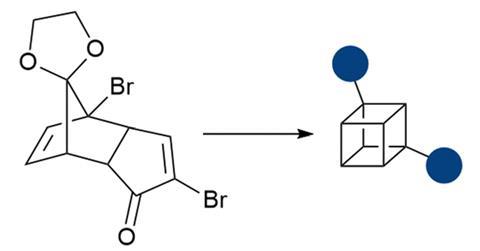
Both of these methods enabled the group to obtain cubanes with much better yields than had previously been thought possible, allowing medicinal chemists to access the milligrams needed for the testing and tweaking of the structures. Coote developed a new method to take the synthesis even further with her own research group. Coote says ‘The goal of the further work was to make the 1,3 cubanes on a gram scale instead of just a milligram scale.’ They took an enone that had been used before in a 1,4-cubane synthesis, and rearranged it in three steps before using a light induced photocycloaddition to make a 1,3 disubstituted cubane. Their method was able to be used on a gram scale, helping to give another option for medicinal chemists exploring the novel bioisosteres.
Switching for strain
The research published by MacMillan, Coote, Wiesenfeldt and their colleagues also introduced an additional tool for medicinal chemists. The ability to link a substituted cubane to other compounds mean that cubanes could be used as a building block for bigger molecules by providing a rigid skeletal backbone. By reducing a cubane carboxylate, a cubyl radical can be generated, allowing a copper-mediated radical cross-coupling to occur. The discovery meant a general technique for arylation, alkylation and amination were possible with cubanes. ‘Copper is in a really unique position in that it is ideally suited for the strained nature of these cubanes,’ Wiesenfeldt says.
Spurred on with the discovery of the new methods, synthesis of a series of pharmaceutical analogues began. Lumacaftor, a drug used in the treatment of cystic fibrosis, contains a meta-substituted benzene ring. By synthesising an analogue of the drug and swapping the benzene ring for a 1,3-disubstituted cubane, the brand-new molecule cuba-lumacaftor is created. When tested in cells cuba-lumacaftor had some surprising properties. The compound was metabolically stable, and while not as bioactive as lumacaftor it still showed relatively high activity in the cells. The most positive result however came when looking at solubility; a drug like lumacaftor needs to pass through the gastrointestinal tract, and high levels of solubility make this possible. Cuba-lumacaftor does not have the pi-pi stacking interactions of its benzene-containing parent molecule and when combined with a modulated acidity of the carboxylic acid moiety, this means it exhibits significantly improved solubility in the relevant pH ranges.
It is basic science like this that leads to major scientific discoveries
Switching out benzene rings for strained molecules has given chemists food for thought before. Williams, who had previously looked at the cubane containing bioisosteres, has also collaborated in the area with medicinal chemists such as Matthew Todd from UCL. The results from the study showed a variety of ring swaps in the new molecules could show bioactivity against the Plasmodium falciparum parasite, the cause of malaria, when compared to their parent molecules, the ‘Series 4’ triazolopyrazine antimalarials. The compounds contain two separate substituted benzene rings, and the study encompassed 32 new compounds being looked at as each ring was tweaked. It wasn’t just cubanes featuring as benzene bioisosteres, however: other bioisosteres such as bicyclo[1.1.1]pentanes (BCPs) made an appearance in the work. The spiky, triangular structure is a bridged cyclobutene, and had previously been shown to have increased solubility when replacing benzene in an Lp-PLA2 inhibitor called darapladib. It showed increased solubility in the novel antimalarials but did also exhibit lower cytotoxicity limiting its effectiveness in these drugs.
Evidence showing that these new drugs can be effective without phenyl rings helps to open up options for future diseases and current ones that need treatment. Williams, who helped to provide some of the building blocks for the study, says that fundamental basic research allows these new molecules to be found. ‘It is very important to note that the current interest in these highly strained molecules has only been made possible due to past heroic efforts in basic science, whereby chemists in the 1960s, 70s, 80s and 90s pursued the synthesis of fundamental molecules to expand the boundaries of chemical knowledge. It is basic science like this that leads to major scientific discoveries that benefit all of humankind.’
Buying bioisosteres
Chemists wanting to get their hands on strained bioisosteres for their own work certainly have more options than those in previous generations. There is a growing field of companies synthesising and selling building blocks to medicinal chemists and pharmaceutical companies. Pavel Mykhailiuk, a chemist based in Kyiv, Ukraine, and the chief scientific officer at Enamine, a company specializing in synthesizing building blocks for medicinal chemists, explains: ‘It’s not just cubanes that people are interested in buying; in recent years bicyclics, for example, have also been of interest, so saturated bioisosteres are increasingly popular and we are seeing a lot of demand for them.’ At Enamine, the goal is to provide chemists with materials that they can easily incorporate, but would otherwise be time consuming to synthesise. ‘Medicinal chemists don’t want to do everything, they want to save time,’ Mykhailiuk says. When Mykhailiuk was awarded a European Research Council grant to investigate saturated bioisosteres including cubanes and bicyclopentanes, it was the first grant of its type in 20 years to be awarded to a project manager at a commercial company, not an academic institution.
Although the accessibility of cubanes is increasing, they remain relatively expensive. A gram of a simple 1,4-disubstituted cubane will set you back around $2500 (£2000). As they become more accessible, however, saturated bioisosteres should come down in price, Mykhailiuk explains. ‘Over time the cost will get cheaper and cheaper: if you look at bicyclo[1.1.1]pentanes 10 years ago they cost a fortune, a couple of thousand dollars for a gram. If you look at them now, we have a synthesis that can produce kilograms of them, in a day, and the price is around $10 a gram.’
Thinking outside the box
While the hype around cubane is showing promising results, other saturated bioisosteres also have promising results and groups are working to not only synthesise but test structures that have unconventional geometries. Cuneane, is one such structure, it is named after the Latin word cuneus, which means wedge. It has the same structural formula as cubane (C8 H8) but is traditionally formed after a silver-catalysed isomerisation reaction shifting to a structure that contains pairs of triangular, quadrilateral and pentagonal faces. Corey Stephenson, from the University of Michigan in the US, worked with cuneanes in assessing their ability to act as phenyl bioisosteres. ‘We originally started looking at amino cubanes, but found that they were lacking some stability, finding that in some cases the rings would open to release strain or react to form ketones,’ he says. ‘We looked at cuneanes to see whether they were more stable and to due to their ability to be either di, or poly substituted.’
Stephenson’s group identified that cuneanes can be formed in a regioselective manner from cubanes that are already substituted, meaning that the structures can mimic substituted benzenes. He points out that lots of saturated bioisosteres are becoming easier to access but there are still challenges that need to be overcome. ‘When you look at some of these scaffolds, you can now get a hold of the simple structures much more easily and people are starting to be able to do selective functionalisation of them. The methods to put functional groups on the arms of these structures are slightly less well developed. That’s a challenge for synthetic chemists. The other option is what we do, which is to come up with a de novo synthesis that allows you to put the groups in a variety of positions.’
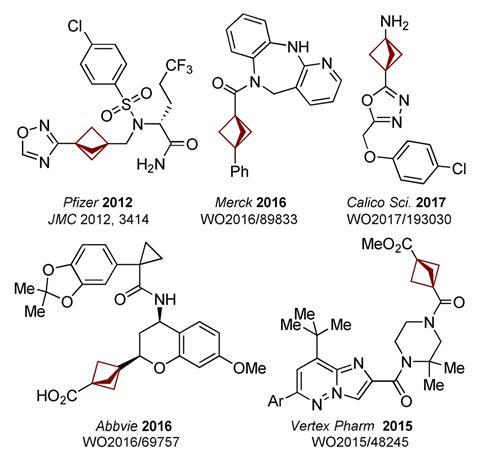
Bicyclopentanes (BCPs), which featured in Todd and Williams’ anti-malarial study, are another molecule to have piqued the interest of chemists for their ability to mimic the features of benzene. But while these contain five carbon atoms, work making bicyclohexanes (BCHs) accessible has been the focus of work by David Procter and Giacomo Crisenza, both from the University of Manchester in the UK. ‘We needed more general ways to make this type of compound; previous methods were fairly narrow with the products they could make, making only a specific type of BCH, featuring a limited selection of functionalities at fixed positions,’ Procter says. ‘The previous method was good and used a photo addition reaction, but our method uses a catalytic process and can take into account a wide range of starting materials so is more flexible.’ The new process to prepare these BCHs uses samarium iodide in a catalytic amount, Crisenza says. ‘This is the first time that samarium diiodide can be used in a truly catalytic amount, as if it was a transition metal catalyst.’
Previous work on BCHs conducted by Mykhailiuk and co-workers had confirmed common properties of successful benzene bioisosteres: they are usually more soluble, more lipophilic and generally have higher metabolic stability than their benzene-containing counterparts. But like many other structures in this new and growing field, they remained under-researched. Procter highlights this is just the beginning of the new field. ‘I think it’s going to be a long path forwards, and with lots of contributions from lots of different areas. Before you can judge how good these bioisosteres are in general, you’re going to need a toolbox of methods and molecules and be able to select which ones work best for your particular system.’
Drug discovery is a long and arduous process, and it will probably be a while before commercially available drugs arrive with strained hydrocarbon systems within them. ‘There is clear and vocal interest by medicinal chemists in these strained molecules,’ Wiesenfeldt says. ‘But it will probably be eight to 10 years until we start to see commercial cubane-containing drugs if it is successful.’ Coote points out that there needs to be ‘a much more efficient way to scale up cubanes and incorporate them’, before we see cubanes in particular in our drugs. ‘I think we need to see something from scratch, in terms of cubane synthesis that is easy to scale up. I think until that happens, I don’t see the rollout of these types of drugs happening soon.’ Williams highlights that ‘Drug, agrichemical and materials discovery programs need as many tools in the toolbox as possible and in this regard I think highly strained molecules will continue to make significant contributions.’
Whether we will see strained bioisosteres in commercially available drugs remains to be determined. But one thing is sure, Eaton’s vision of cubane as a benzene replacement was ahead of its time. Coote says ‘most people didn’t think cubane could even be made in the very early 60s, so going from that to him saying in the 90s that it could be a bioisostere is a brilliant idea in hindsight.’ At the end of his groundbreaking paper in 1992, Eaton described his hopes for the future of cubane that are now starting to be realised, writing how he would like to see cubane transformed from ‘a laboratory curiosity to an industrial material.’ It may take a while to see commercial cubane products, but we are certainly close to clinically useful materials now than just laboratory curiosities.
George Barsted is a science writer based in King’s Lynn, UK

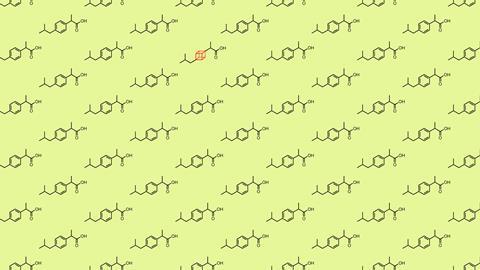



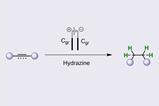

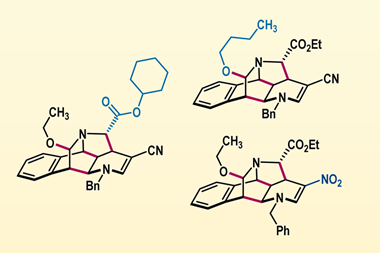










No comments yet